Analyzing Corporate and Financial Accounting: Fund Sources Report
VerifiedAdded on 2022/11/29
|17
|3842
|301
Report
AI Summary
This report provides a comprehensive analysis of corporate and financial accounting, focusing on the various sources of funds available to companies. It begins by classifying fund sources based on time period (long-term, medium-term, and short-term), ownership (owner's capital and borrowed funds), and source (internal and external). The report then delves into the specifics of owner's equity, including components like retained earnings, outstanding shares, and paid-up capital, as well as the recording of owner's equity in financial statements. Furthermore, the report examines liabilities, including trade payables, long-term loans, interest payable, and provisions, and how they are determined and recorded. A comparative analysis of two Australian companies, Wesfarmers and BHP, is undertaken to identify their respective sources of funds. The report also discusses the advantages of different fund sources, such as bank loans, including factors like bank influence, accessibility, and interest rates. The report concludes with a discussion on the advantages and disadvantages of different sources of funds.
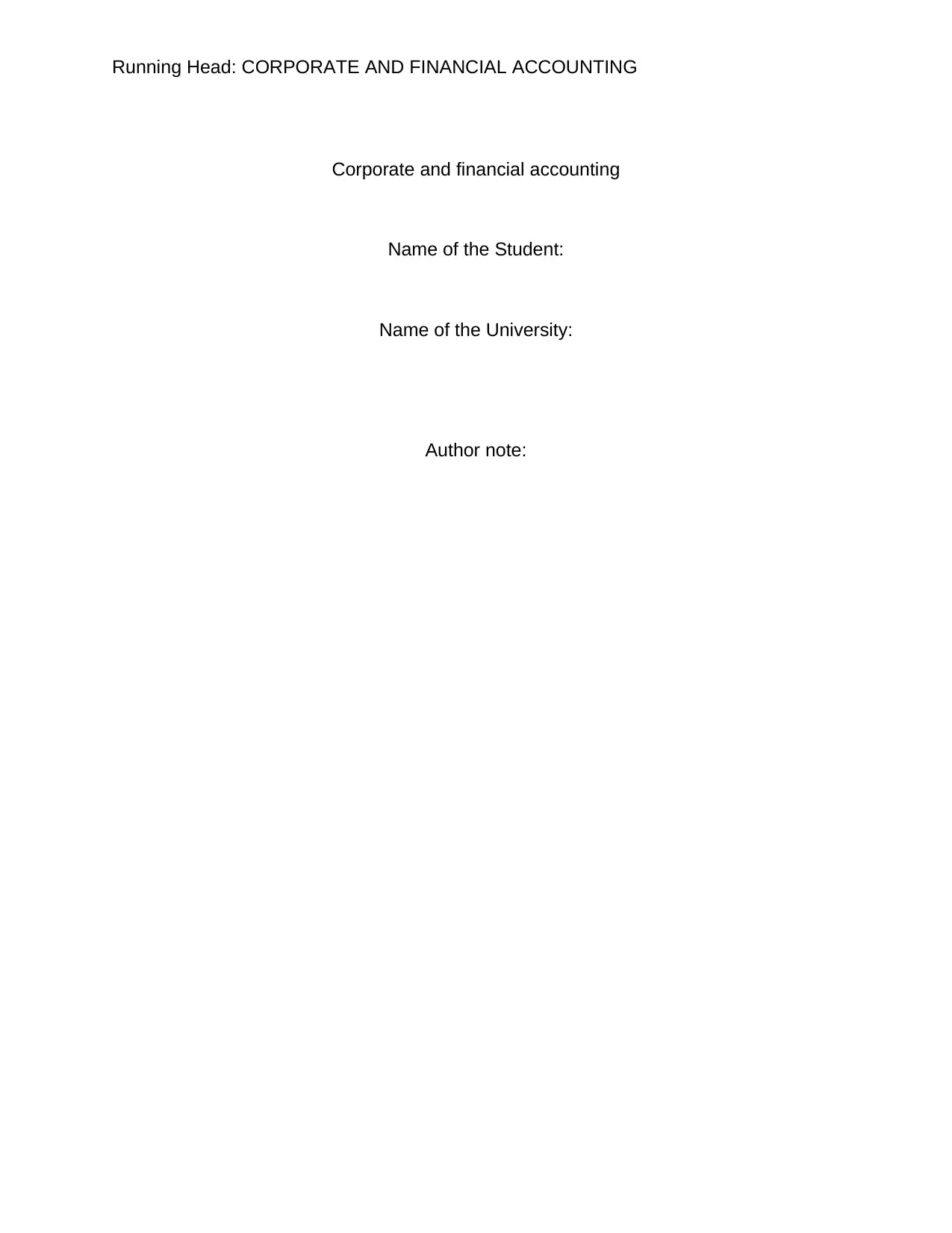
Running Head: CORPORATE AND FINANCIAL ACCOUNTING
Corporate and financial accounting
Name of the Student:
Name of the University:
Author note:
Corporate and financial accounting
Name of the Student:
Name of the University:
Author note:
Paraphrase This Document
Need a fresh take? Get an instant paraphrase of this document with our AI Paraphraser
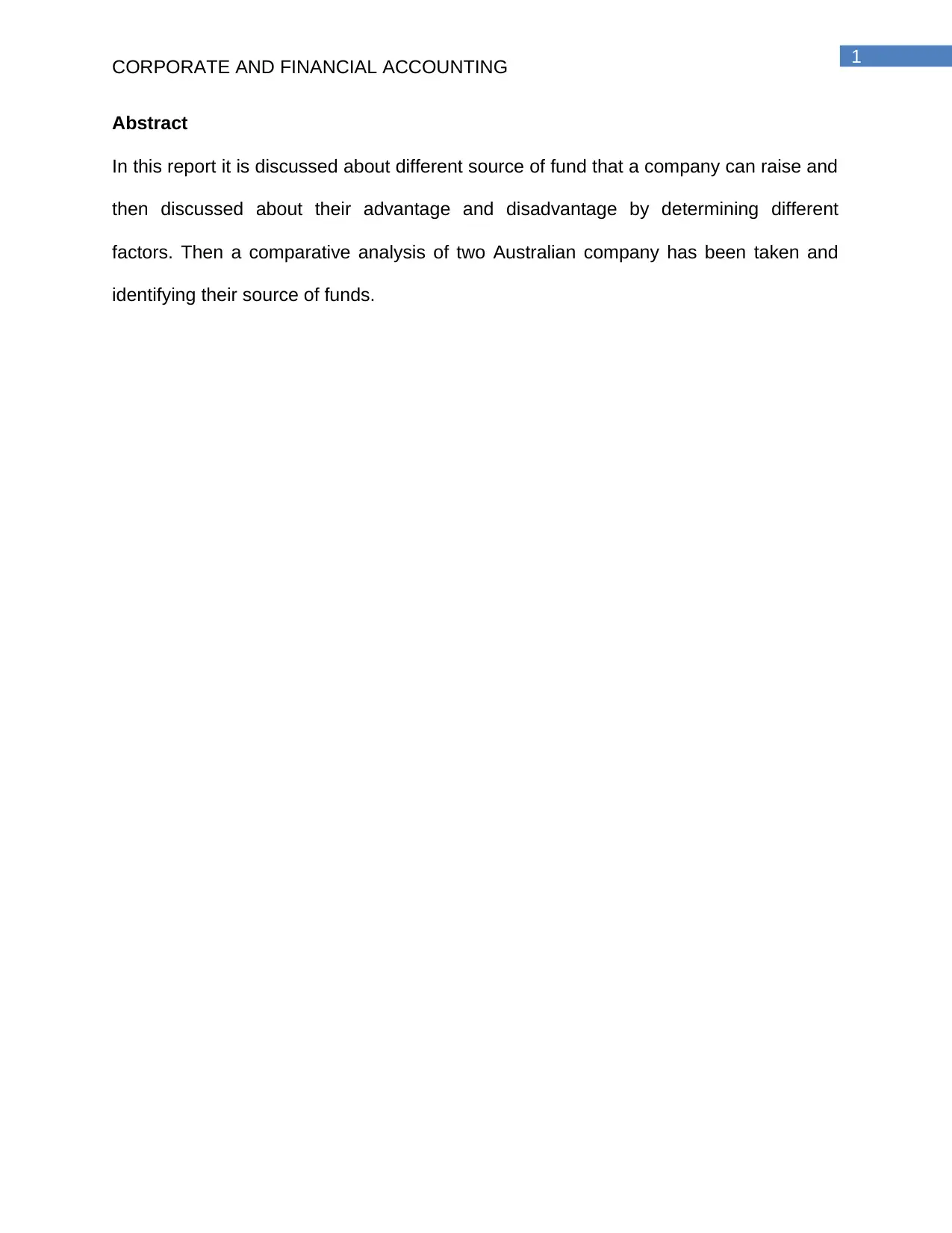
1
CORPORATE AND FINANCIAL ACCOUNTING
Abstract
In this report it is discussed about different source of fund that a company can raise and
then discussed about their advantage and disadvantage by determining different
factors. Then a comparative analysis of two Australian company has been taken and
identifying their source of funds.
CORPORATE AND FINANCIAL ACCOUNTING
Abstract
In this report it is discussed about different source of fund that a company can raise and
then discussed about their advantage and disadvantage by determining different
factors. Then a comparative analysis of two Australian company has been taken and
identifying their source of funds.
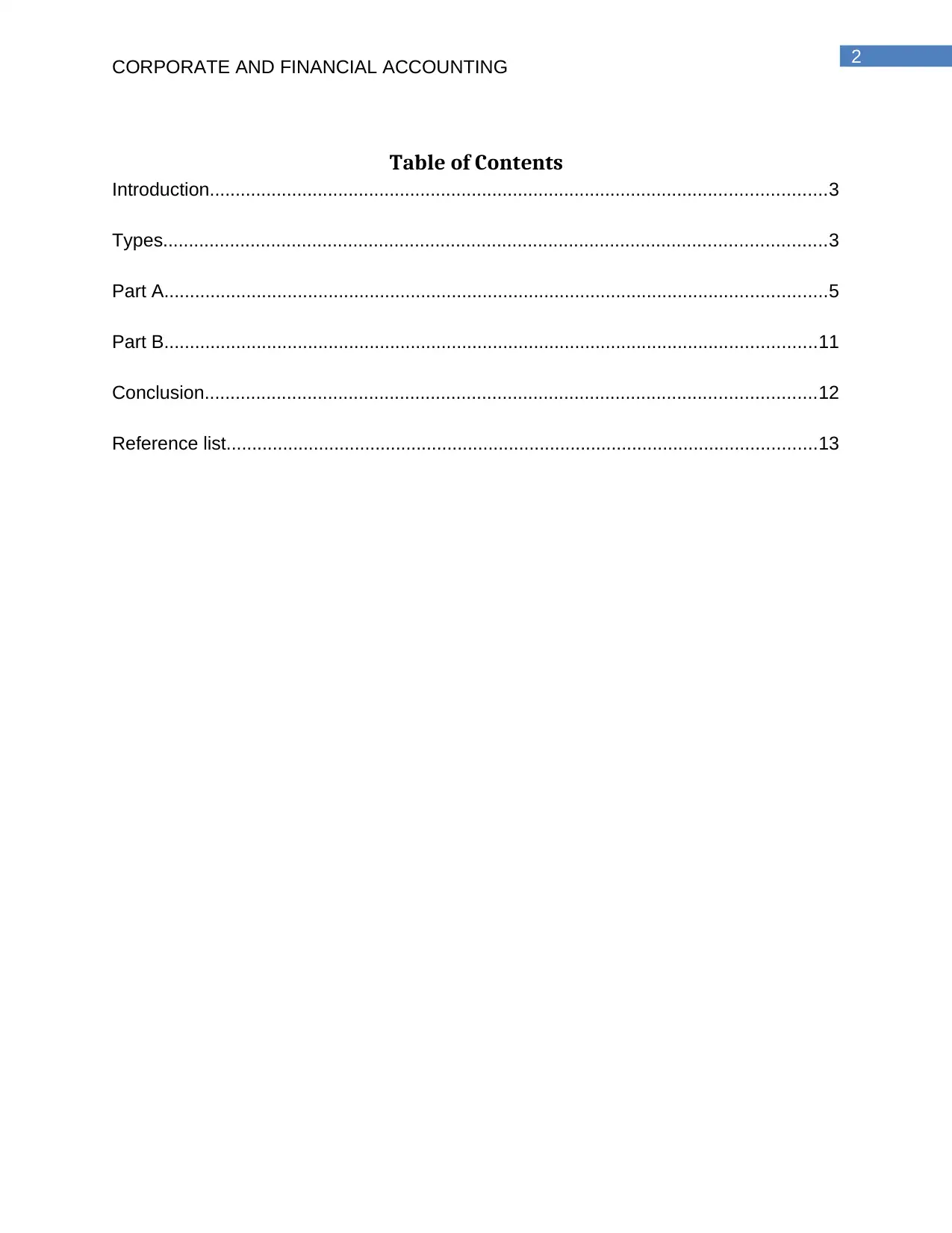
2
CORPORATE AND FINANCIAL ACCOUNTING
Table of Contents
Introduction........................................................................................................................3
Types.................................................................................................................................3
Part A.................................................................................................................................5
Part B...............................................................................................................................11
Conclusion.......................................................................................................................12
Reference list...................................................................................................................13
CORPORATE AND FINANCIAL ACCOUNTING
Table of Contents
Introduction........................................................................................................................3
Types.................................................................................................................................3
Part A.................................................................................................................................5
Part B...............................................................................................................................11
Conclusion.......................................................................................................................12
Reference list...................................................................................................................13
⊘ This is a preview!⊘
Do you want full access?
Subscribe today to unlock all pages.

Trusted by 1+ million students worldwide
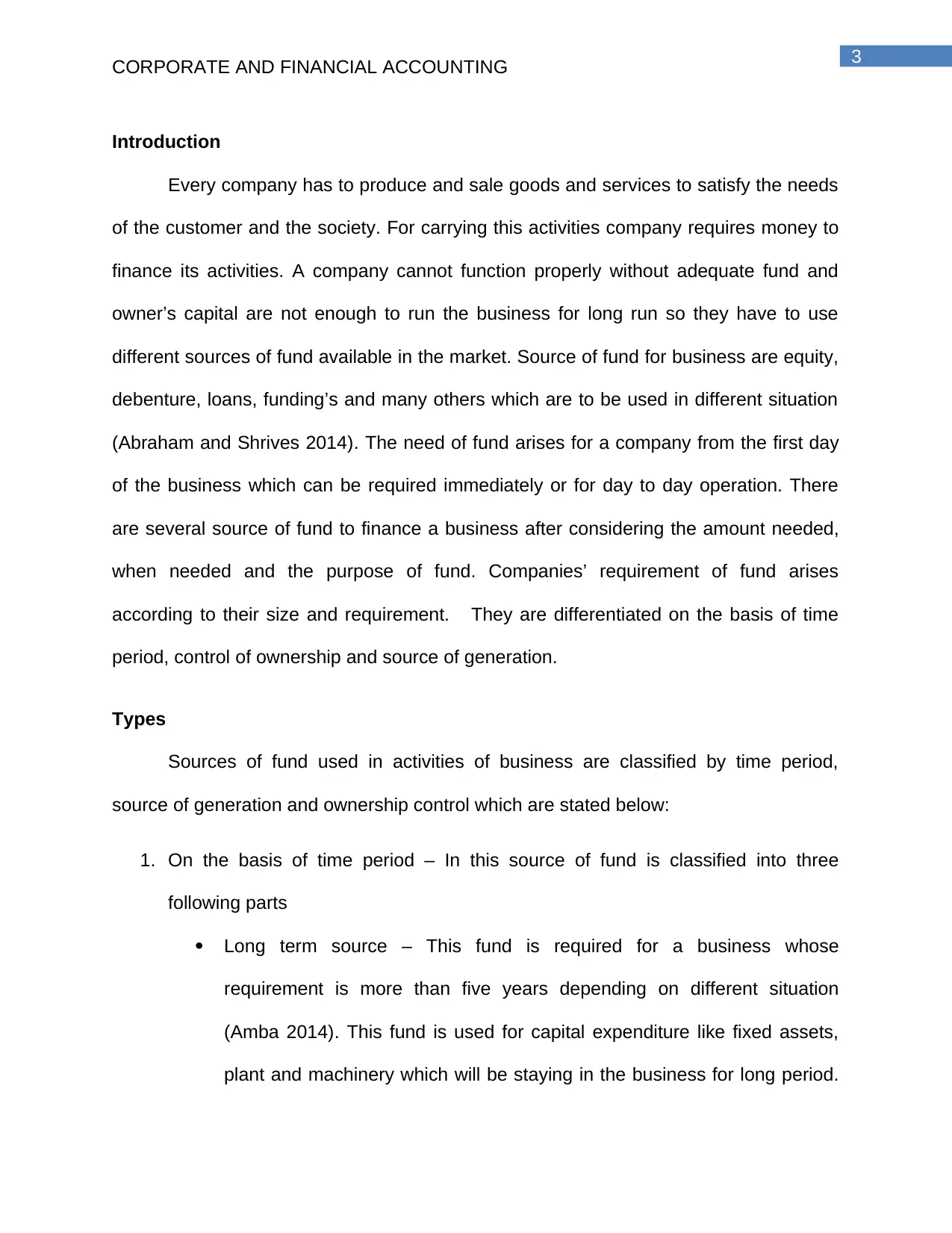
3
CORPORATE AND FINANCIAL ACCOUNTING
Introduction
Every company has to produce and sale goods and services to satisfy the needs
of the customer and the society. For carrying this activities company requires money to
finance its activities. A company cannot function properly without adequate fund and
owner’s capital are not enough to run the business for long run so they have to use
different sources of fund available in the market. Source of fund for business are equity,
debenture, loans, funding’s and many others which are to be used in different situation
(Abraham and Shrives 2014). The need of fund arises for a company from the first day
of the business which can be required immediately or for day to day operation. There
are several source of fund to finance a business after considering the amount needed,
when needed and the purpose of fund. Companies’ requirement of fund arises
according to their size and requirement. They are differentiated on the basis of time
period, control of ownership and source of generation.
Types
Sources of fund used in activities of business are classified by time period,
source of generation and ownership control which are stated below:
1. On the basis of time period – In this source of fund is classified into three
following parts
Long term source – This fund is required for a business whose
requirement is more than five years depending on different situation
(Amba 2014). This fund is used for capital expenditure like fixed assets,
plant and machinery which will be staying in the business for long period.
CORPORATE AND FINANCIAL ACCOUNTING
Introduction
Every company has to produce and sale goods and services to satisfy the needs
of the customer and the society. For carrying this activities company requires money to
finance its activities. A company cannot function properly without adequate fund and
owner’s capital are not enough to run the business for long run so they have to use
different sources of fund available in the market. Source of fund for business are equity,
debenture, loans, funding’s and many others which are to be used in different situation
(Abraham and Shrives 2014). The need of fund arises for a company from the first day
of the business which can be required immediately or for day to day operation. There
are several source of fund to finance a business after considering the amount needed,
when needed and the purpose of fund. Companies’ requirement of fund arises
according to their size and requirement. They are differentiated on the basis of time
period, control of ownership and source of generation.
Types
Sources of fund used in activities of business are classified by time period,
source of generation and ownership control which are stated below:
1. On the basis of time period – In this source of fund is classified into three
following parts
Long term source – This fund is required for a business whose
requirement is more than five years depending on different situation
(Amba 2014). This fund is used for capital expenditure like fixed assets,
plant and machinery which will be staying in the business for long period.
Paraphrase This Document
Need a fresh take? Get an instant paraphrase of this document with our AI Paraphraser
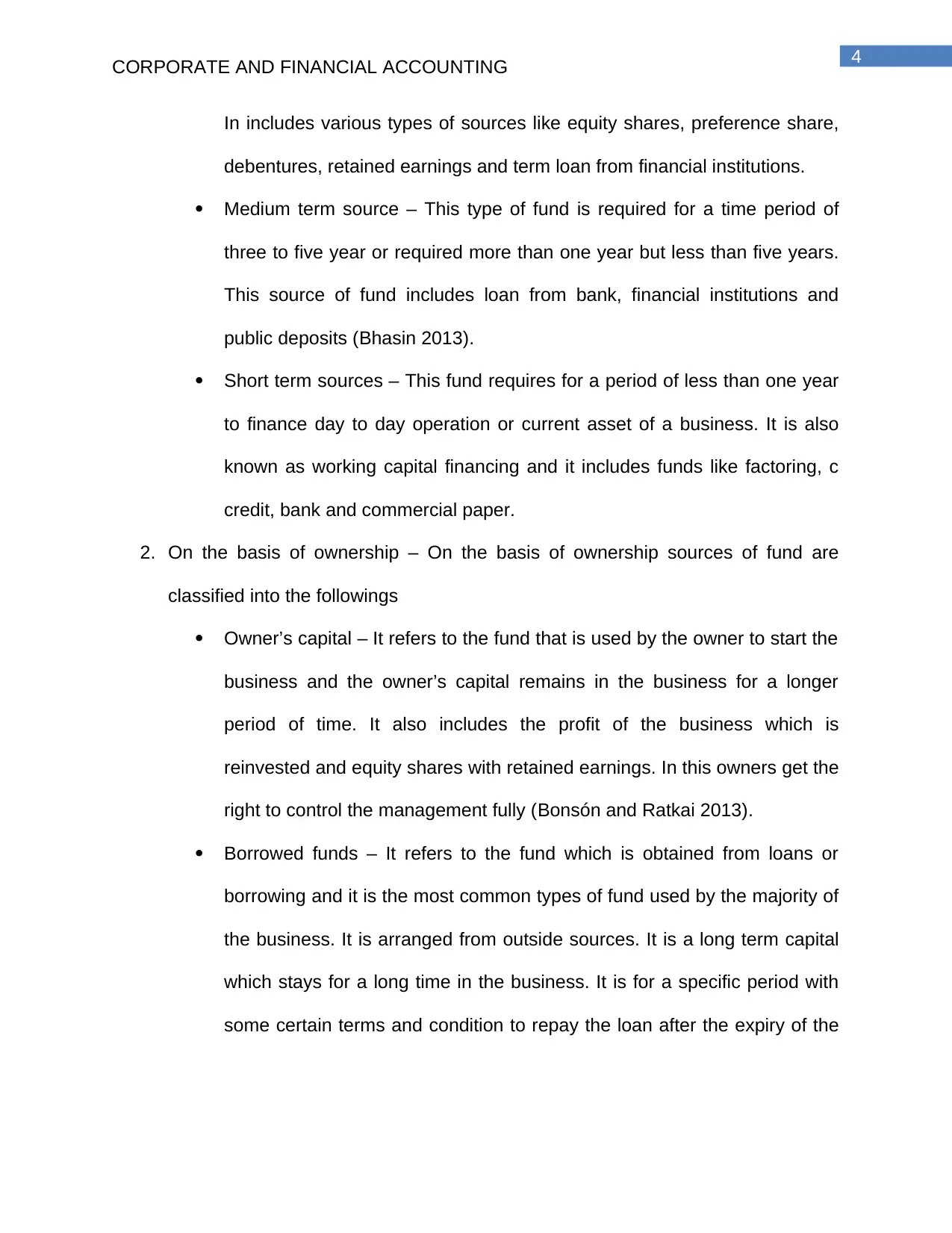
4
CORPORATE AND FINANCIAL ACCOUNTING
In includes various types of sources like equity shares, preference share,
debentures, retained earnings and term loan from financial institutions.
Medium term source – This type of fund is required for a time period of
three to five year or required more than one year but less than five years.
This source of fund includes loan from bank, financial institutions and
public deposits (Bhasin 2013).
Short term sources – This fund requires for a period of less than one year
to finance day to day operation or current asset of a business. It is also
known as working capital financing and it includes funds like factoring, c
credit, bank and commercial paper.
2. On the basis of ownership – On the basis of ownership sources of fund are
classified into the followings
Owner’s capital – It refers to the fund that is used by the owner to start the
business and the owner’s capital remains in the business for a longer
period of time. It also includes the profit of the business which is
reinvested and equity shares with retained earnings. In this owners get the
right to control the management fully (Bonsón and Ratkai 2013).
Borrowed funds – It refers to the fund which is obtained from loans or
borrowing and it is the most common types of fund used by the majority of
the business. It is arranged from outside sources. It is a long term capital
which stays for a long time in the business. It is for a specific period with
some certain terms and condition to repay the loan after the expiry of the
CORPORATE AND FINANCIAL ACCOUNTING
In includes various types of sources like equity shares, preference share,
debentures, retained earnings and term loan from financial institutions.
Medium term source – This type of fund is required for a time period of
three to five year or required more than one year but less than five years.
This source of fund includes loan from bank, financial institutions and
public deposits (Bhasin 2013).
Short term sources – This fund requires for a period of less than one year
to finance day to day operation or current asset of a business. It is also
known as working capital financing and it includes funds like factoring, c
credit, bank and commercial paper.
2. On the basis of ownership – On the basis of ownership sources of fund are
classified into the followings
Owner’s capital – It refers to the fund that is used by the owner to start the
business and the owner’s capital remains in the business for a longer
period of time. It also includes the profit of the business which is
reinvested and equity shares with retained earnings. In this owners get the
right to control the management fully (Bonsón and Ratkai 2013).
Borrowed funds – It refers to the fund which is obtained from loans or
borrowing and it is the most common types of fund used by the majority of
the business. It is arranged from outside sources. It is a long term capital
which stays for a long time in the business. It is for a specific period with
some certain terms and condition to repay the loan after the expiry of the
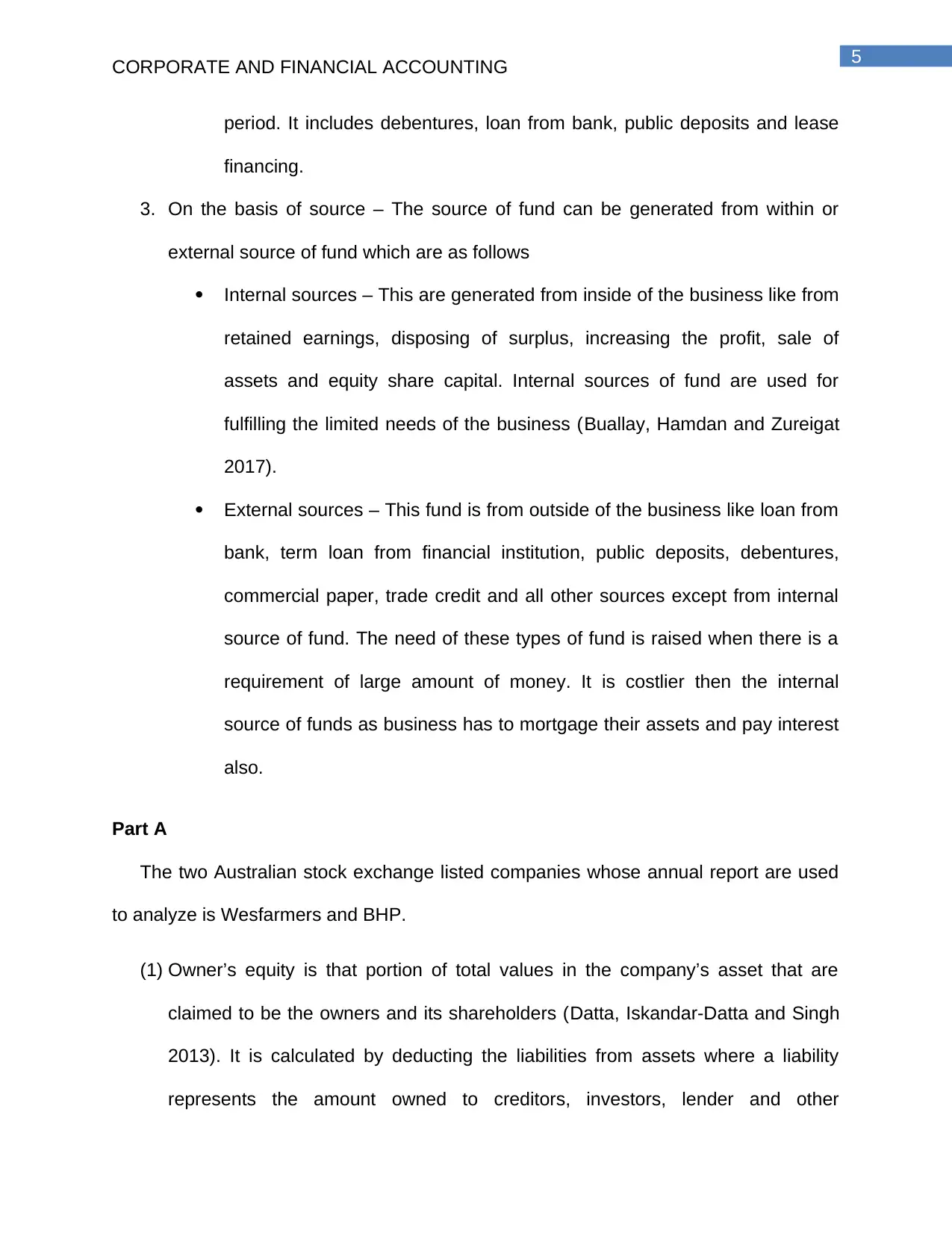
5
CORPORATE AND FINANCIAL ACCOUNTING
period. It includes debentures, loan from bank, public deposits and lease
financing.
3. On the basis of source – The source of fund can be generated from within or
external source of fund which are as follows
Internal sources – This are generated from inside of the business like from
retained earnings, disposing of surplus, increasing the profit, sale of
assets and equity share capital. Internal sources of fund are used for
fulfilling the limited needs of the business (Buallay, Hamdan and Zureigat
2017).
External sources – This fund is from outside of the business like loan from
bank, term loan from financial institution, public deposits, debentures,
commercial paper, trade credit and all other sources except from internal
source of fund. The need of these types of fund is raised when there is a
requirement of large amount of money. It is costlier then the internal
source of funds as business has to mortgage their assets and pay interest
also.
Part A
The two Australian stock exchange listed companies whose annual report are used
to analyze is Wesfarmers and BHP.
(1) Owner’s equity is that portion of total values in the company’s asset that are
claimed to be the owners and its shareholders (Datta, Iskandar-Datta and Singh
2013). It is calculated by deducting the liabilities from assets where a liability
represents the amount owned to creditors, investors, lender and other
CORPORATE AND FINANCIAL ACCOUNTING
period. It includes debentures, loan from bank, public deposits and lease
financing.
3. On the basis of source – The source of fund can be generated from within or
external source of fund which are as follows
Internal sources – This are generated from inside of the business like from
retained earnings, disposing of surplus, increasing the profit, sale of
assets and equity share capital. Internal sources of fund are used for
fulfilling the limited needs of the business (Buallay, Hamdan and Zureigat
2017).
External sources – This fund is from outside of the business like loan from
bank, term loan from financial institution, public deposits, debentures,
commercial paper, trade credit and all other sources except from internal
source of fund. The need of these types of fund is raised when there is a
requirement of large amount of money. It is costlier then the internal
source of funds as business has to mortgage their assets and pay interest
also.
Part A
The two Australian stock exchange listed companies whose annual report are used
to analyze is Wesfarmers and BHP.
(1) Owner’s equity is that portion of total values in the company’s asset that are
claimed to be the owners and its shareholders (Datta, Iskandar-Datta and Singh
2013). It is calculated by deducting the liabilities from assets where a liability
represents the amount owned to creditors, investors, lender and other
⊘ This is a preview!⊘
Do you want full access?
Subscribe today to unlock all pages.

Trusted by 1+ million students worldwide
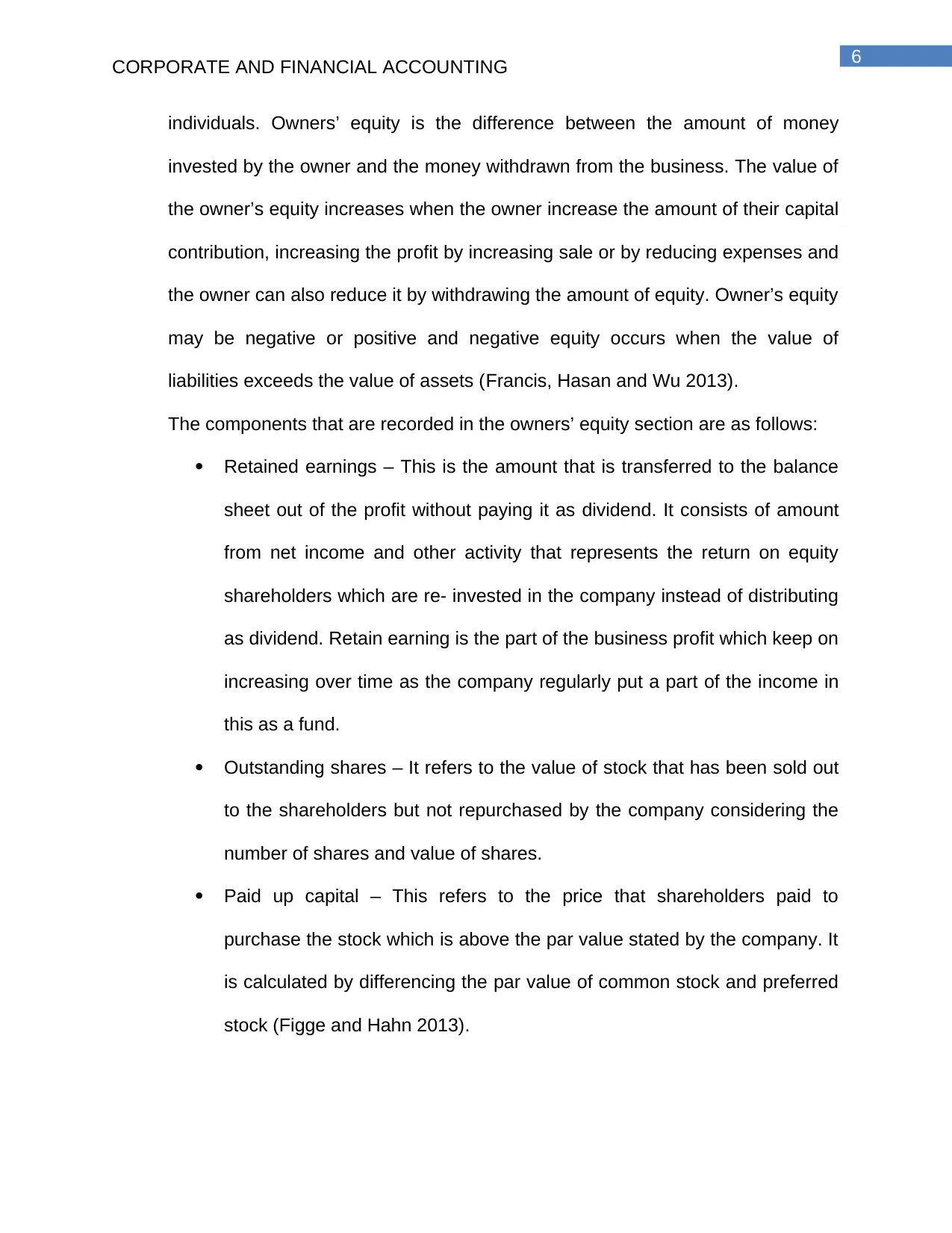
6
CORPORATE AND FINANCIAL ACCOUNTING
individuals. Owners’ equity is the difference between the amount of money
invested by the owner and the money withdrawn from the business. The value of
the owner’s equity increases when the owner increase the amount of their capital
contribution, increasing the profit by increasing sale or by reducing expenses and
the owner can also reduce it by withdrawing the amount of equity. Owner’s equity
may be negative or positive and negative equity occurs when the value of
liabilities exceeds the value of assets (Francis, Hasan and Wu 2013).
The components that are recorded in the owners’ equity section are as follows:
Retained earnings – This is the amount that is transferred to the balance
sheet out of the profit without paying it as dividend. It consists of amount
from net income and other activity that represents the return on equity
shareholders which are re- invested in the company instead of distributing
as dividend. Retain earning is the part of the business profit which keep on
increasing over time as the company regularly put a part of the income in
this as a fund.
Outstanding shares – It refers to the value of stock that has been sold out
to the shareholders but not repurchased by the company considering the
number of shares and value of shares.
Paid up capital – This refers to the price that shareholders paid to
purchase the stock which is above the par value stated by the company. It
is calculated by differencing the par value of common stock and preferred
stock (Figge and Hahn 2013).
CORPORATE AND FINANCIAL ACCOUNTING
individuals. Owners’ equity is the difference between the amount of money
invested by the owner and the money withdrawn from the business. The value of
the owner’s equity increases when the owner increase the amount of their capital
contribution, increasing the profit by increasing sale or by reducing expenses and
the owner can also reduce it by withdrawing the amount of equity. Owner’s equity
may be negative or positive and negative equity occurs when the value of
liabilities exceeds the value of assets (Francis, Hasan and Wu 2013).
The components that are recorded in the owners’ equity section are as follows:
Retained earnings – This is the amount that is transferred to the balance
sheet out of the profit without paying it as dividend. It consists of amount
from net income and other activity that represents the return on equity
shareholders which are re- invested in the company instead of distributing
as dividend. Retain earning is the part of the business profit which keep on
increasing over time as the company regularly put a part of the income in
this as a fund.
Outstanding shares – It refers to the value of stock that has been sold out
to the shareholders but not repurchased by the company considering the
number of shares and value of shares.
Paid up capital – This refers to the price that shareholders paid to
purchase the stock which is above the par value stated by the company. It
is calculated by differencing the par value of common stock and preferred
stock (Figge and Hahn 2013).
Paraphrase This Document
Need a fresh take? Get an instant paraphrase of this document with our AI Paraphraser
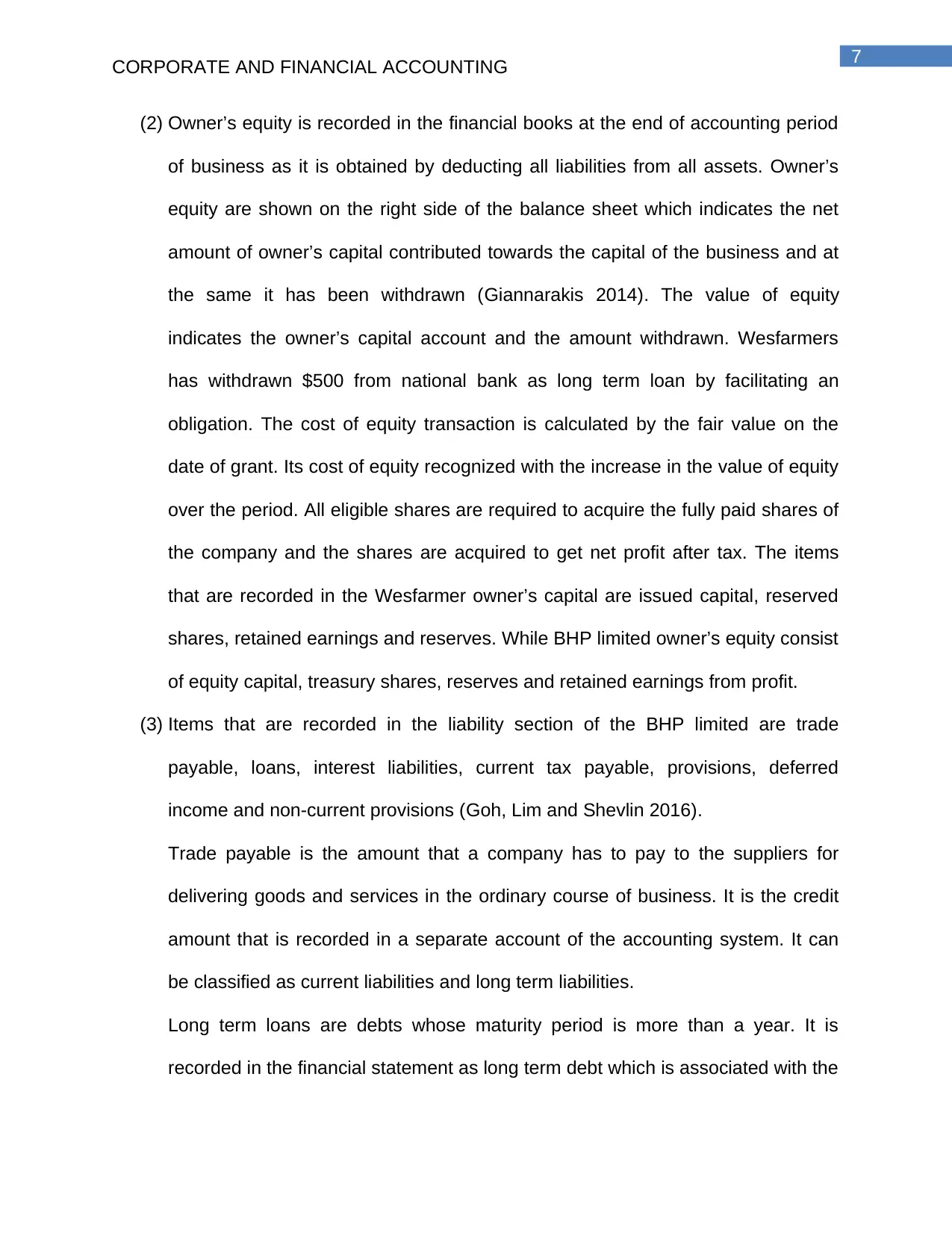
7
CORPORATE AND FINANCIAL ACCOUNTING
(2) Owner’s equity is recorded in the financial books at the end of accounting period
of business as it is obtained by deducting all liabilities from all assets. Owner’s
equity are shown on the right side of the balance sheet which indicates the net
amount of owner’s capital contributed towards the capital of the business and at
the same it has been withdrawn (Giannarakis 2014). The value of equity
indicates the owner’s capital account and the amount withdrawn. Wesfarmers
has withdrawn $500 from national bank as long term loan by facilitating an
obligation. The cost of equity transaction is calculated by the fair value on the
date of grant. Its cost of equity recognized with the increase in the value of equity
over the period. All eligible shares are required to acquire the fully paid shares of
the company and the shares are acquired to get net profit after tax. The items
that are recorded in the Wesfarmer owner’s capital are issued capital, reserved
shares, retained earnings and reserves. While BHP limited owner’s equity consist
of equity capital, treasury shares, reserves and retained earnings from profit.
(3) Items that are recorded in the liability section of the BHP limited are trade
payable, loans, interest liabilities, current tax payable, provisions, deferred
income and non-current provisions (Goh, Lim and Shevlin 2016).
Trade payable is the amount that a company has to pay to the suppliers for
delivering goods and services in the ordinary course of business. It is the credit
amount that is recorded in a separate account of the accounting system. It can
be classified as current liabilities and long term liabilities.
Long term loans are debts whose maturity period is more than a year. It is
recorded in the financial statement as long term debt which is associated with the
CORPORATE AND FINANCIAL ACCOUNTING
(2) Owner’s equity is recorded in the financial books at the end of accounting period
of business as it is obtained by deducting all liabilities from all assets. Owner’s
equity are shown on the right side of the balance sheet which indicates the net
amount of owner’s capital contributed towards the capital of the business and at
the same it has been withdrawn (Giannarakis 2014). The value of equity
indicates the owner’s capital account and the amount withdrawn. Wesfarmers
has withdrawn $500 from national bank as long term loan by facilitating an
obligation. The cost of equity transaction is calculated by the fair value on the
date of grant. Its cost of equity recognized with the increase in the value of equity
over the period. All eligible shares are required to acquire the fully paid shares of
the company and the shares are acquired to get net profit after tax. The items
that are recorded in the Wesfarmer owner’s capital are issued capital, reserved
shares, retained earnings and reserves. While BHP limited owner’s equity consist
of equity capital, treasury shares, reserves and retained earnings from profit.
(3) Items that are recorded in the liability section of the BHP limited are trade
payable, loans, interest liabilities, current tax payable, provisions, deferred
income and non-current provisions (Goh, Lim and Shevlin 2016).
Trade payable is the amount that a company has to pay to the suppliers for
delivering goods and services in the ordinary course of business. It is the credit
amount that is recorded in a separate account of the accounting system. It can
be classified as current liabilities and long term liabilities.
Long term loans are debts whose maturity period is more than a year. It is
recorded in the financial statement as long term debt which is associated with the
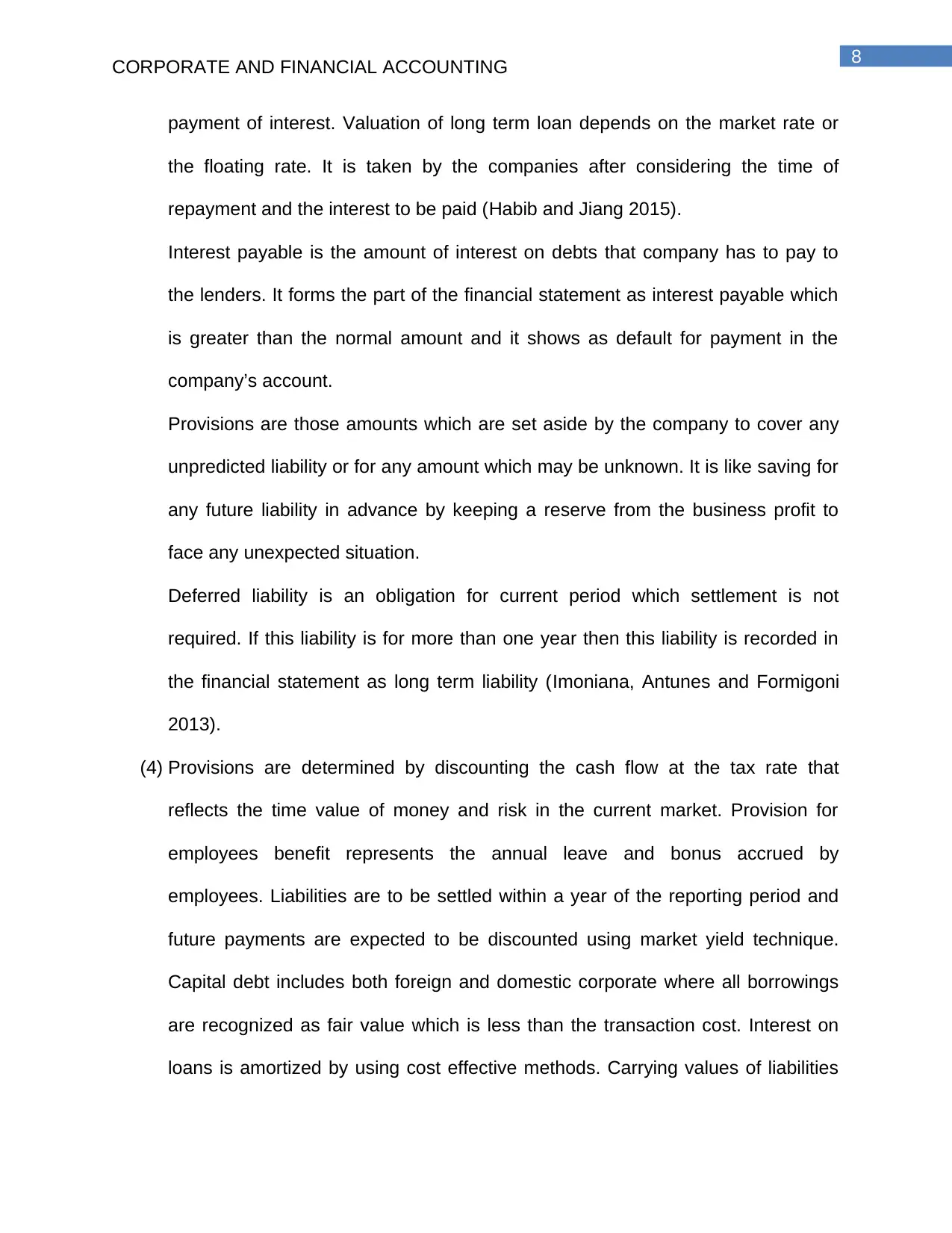
8
CORPORATE AND FINANCIAL ACCOUNTING
payment of interest. Valuation of long term loan depends on the market rate or
the floating rate. It is taken by the companies after considering the time of
repayment and the interest to be paid (Habib and Jiang 2015).
Interest payable is the amount of interest on debts that company has to pay to
the lenders. It forms the part of the financial statement as interest payable which
is greater than the normal amount and it shows as default for payment in the
company’s account.
Provisions are those amounts which are set aside by the company to cover any
unpredicted liability or for any amount which may be unknown. It is like saving for
any future liability in advance by keeping a reserve from the business profit to
face any unexpected situation.
Deferred liability is an obligation for current period which settlement is not
required. If this liability is for more than one year then this liability is recorded in
the financial statement as long term liability (Imoniana, Antunes and Formigoni
2013).
(4) Provisions are determined by discounting the cash flow at the tax rate that
reflects the time value of money and risk in the current market. Provision for
employees benefit represents the annual leave and bonus accrued by
employees. Liabilities are to be settled within a year of the reporting period and
future payments are expected to be discounted using market yield technique.
Capital debt includes both foreign and domestic corporate where all borrowings
are recognized as fair value which is less than the transaction cost. Interest on
loans is amortized by using cost effective methods. Carrying values of liabilities
CORPORATE AND FINANCIAL ACCOUNTING
payment of interest. Valuation of long term loan depends on the market rate or
the floating rate. It is taken by the companies after considering the time of
repayment and the interest to be paid (Habib and Jiang 2015).
Interest payable is the amount of interest on debts that company has to pay to
the lenders. It forms the part of the financial statement as interest payable which
is greater than the normal amount and it shows as default for payment in the
company’s account.
Provisions are those amounts which are set aside by the company to cover any
unpredicted liability or for any amount which may be unknown. It is like saving for
any future liability in advance by keeping a reserve from the business profit to
face any unexpected situation.
Deferred liability is an obligation for current period which settlement is not
required. If this liability is for more than one year then this liability is recorded in
the financial statement as long term liability (Imoniana, Antunes and Formigoni
2013).
(4) Provisions are determined by discounting the cash flow at the tax rate that
reflects the time value of money and risk in the current market. Provision for
employees benefit represents the annual leave and bonus accrued by
employees. Liabilities are to be settled within a year of the reporting period and
future payments are expected to be discounted using market yield technique.
Capital debt includes both foreign and domestic corporate where all borrowings
are recognized as fair value which is less than the transaction cost. Interest on
loans is amortized by using cost effective methods. Carrying values of liabilities
⊘ This is a preview!⊘
Do you want full access?
Subscribe today to unlock all pages.

Trusted by 1+ million students worldwide
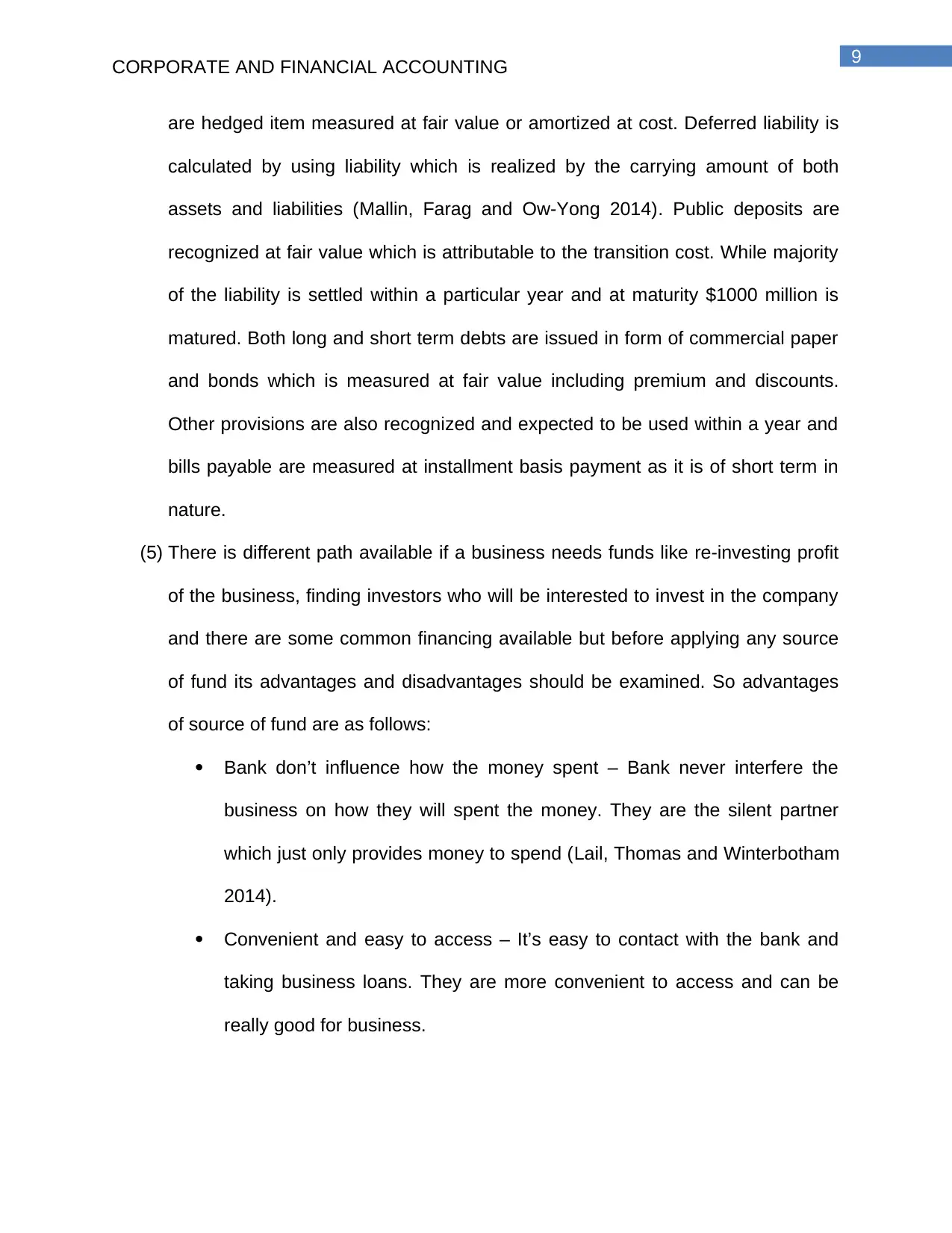
9
CORPORATE AND FINANCIAL ACCOUNTING
are hedged item measured at fair value or amortized at cost. Deferred liability is
calculated by using liability which is realized by the carrying amount of both
assets and liabilities (Mallin, Farag and Ow-Yong 2014). Public deposits are
recognized at fair value which is attributable to the transition cost. While majority
of the liability is settled within a particular year and at maturity $1000 million is
matured. Both long and short term debts are issued in form of commercial paper
and bonds which is measured at fair value including premium and discounts.
Other provisions are also recognized and expected to be used within a year and
bills payable are measured at installment basis payment as it is of short term in
nature.
(5) There is different path available if a business needs funds like re-investing profit
of the business, finding investors who will be interested to invest in the company
and there are some common financing available but before applying any source
of fund its advantages and disadvantages should be examined. So advantages
of source of fund are as follows:
Bank don’t influence how the money spent – Bank never interfere the
business on how they will spent the money. They are the silent partner
which just only provides money to spend (Lail, Thomas and Winterbotham
2014).
Convenient and easy to access – It’s easy to contact with the bank and
taking business loans. They are more convenient to access and can be
really good for business.
CORPORATE AND FINANCIAL ACCOUNTING
are hedged item measured at fair value or amortized at cost. Deferred liability is
calculated by using liability which is realized by the carrying amount of both
assets and liabilities (Mallin, Farag and Ow-Yong 2014). Public deposits are
recognized at fair value which is attributable to the transition cost. While majority
of the liability is settled within a particular year and at maturity $1000 million is
matured. Both long and short term debts are issued in form of commercial paper
and bonds which is measured at fair value including premium and discounts.
Other provisions are also recognized and expected to be used within a year and
bills payable are measured at installment basis payment as it is of short term in
nature.
(5) There is different path available if a business needs funds like re-investing profit
of the business, finding investors who will be interested to invest in the company
and there are some common financing available but before applying any source
of fund its advantages and disadvantages should be examined. So advantages
of source of fund are as follows:
Bank don’t influence how the money spent – Bank never interfere the
business on how they will spent the money. They are the silent partner
which just only provides money to spend (Lail, Thomas and Winterbotham
2014).
Convenient and easy to access – It’s easy to contact with the bank and
taking business loans. They are more convenient to access and can be
really good for business.
Paraphrase This Document
Need a fresh take? Get an instant paraphrase of this document with our AI Paraphraser
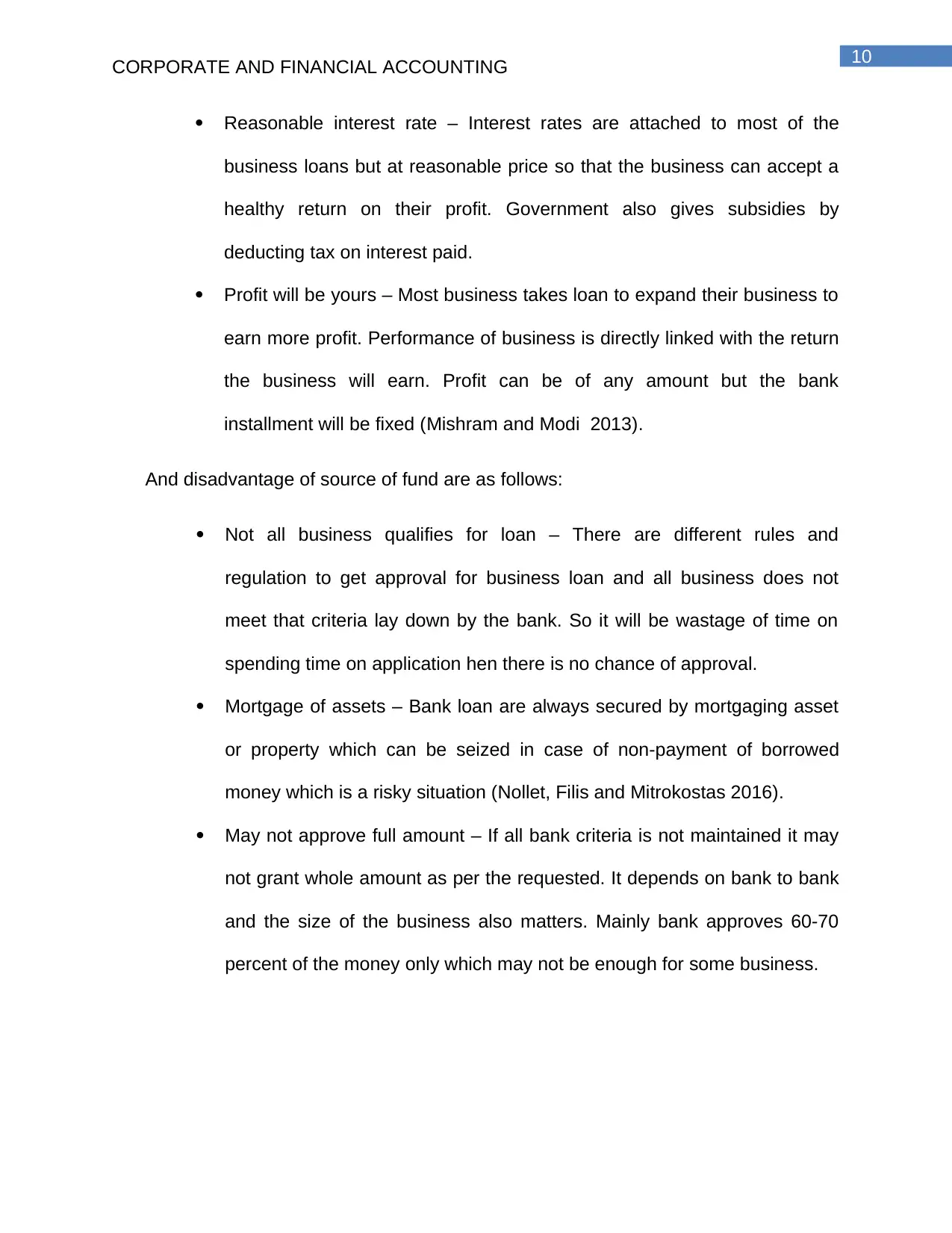
10
CORPORATE AND FINANCIAL ACCOUNTING
Reasonable interest rate – Interest rates are attached to most of the
business loans but at reasonable price so that the business can accept a
healthy return on their profit. Government also gives subsidies by
deducting tax on interest paid.
Profit will be yours – Most business takes loan to expand their business to
earn more profit. Performance of business is directly linked with the return
the business will earn. Profit can be of any amount but the bank
installment will be fixed (Mishram and Modi 2013).
And disadvantage of source of fund are as follows:
Not all business qualifies for loan – There are different rules and
regulation to get approval for business loan and all business does not
meet that criteria lay down by the bank. So it will be wastage of time on
spending time on application hen there is no chance of approval.
Mortgage of assets – Bank loan are always secured by mortgaging asset
or property which can be seized in case of non-payment of borrowed
money which is a risky situation (Nollet, Filis and Mitrokostas 2016).
May not approve full amount – If all bank criteria is not maintained it may
not grant whole amount as per the requested. It depends on bank to bank
and the size of the business also matters. Mainly bank approves 60-70
percent of the money only which may not be enough for some business.
CORPORATE AND FINANCIAL ACCOUNTING
Reasonable interest rate – Interest rates are attached to most of the
business loans but at reasonable price so that the business can accept a
healthy return on their profit. Government also gives subsidies by
deducting tax on interest paid.
Profit will be yours – Most business takes loan to expand their business to
earn more profit. Performance of business is directly linked with the return
the business will earn. Profit can be of any amount but the bank
installment will be fixed (Mishram and Modi 2013).
And disadvantage of source of fund are as follows:
Not all business qualifies for loan – There are different rules and
regulation to get approval for business loan and all business does not
meet that criteria lay down by the bank. So it will be wastage of time on
spending time on application hen there is no chance of approval.
Mortgage of assets – Bank loan are always secured by mortgaging asset
or property which can be seized in case of non-payment of borrowed
money which is a risky situation (Nollet, Filis and Mitrokostas 2016).
May not approve full amount – If all bank criteria is not maintained it may
not grant whole amount as per the requested. It depends on bank to bank
and the size of the business also matters. Mainly bank approves 60-70
percent of the money only which may not be enough for some business.
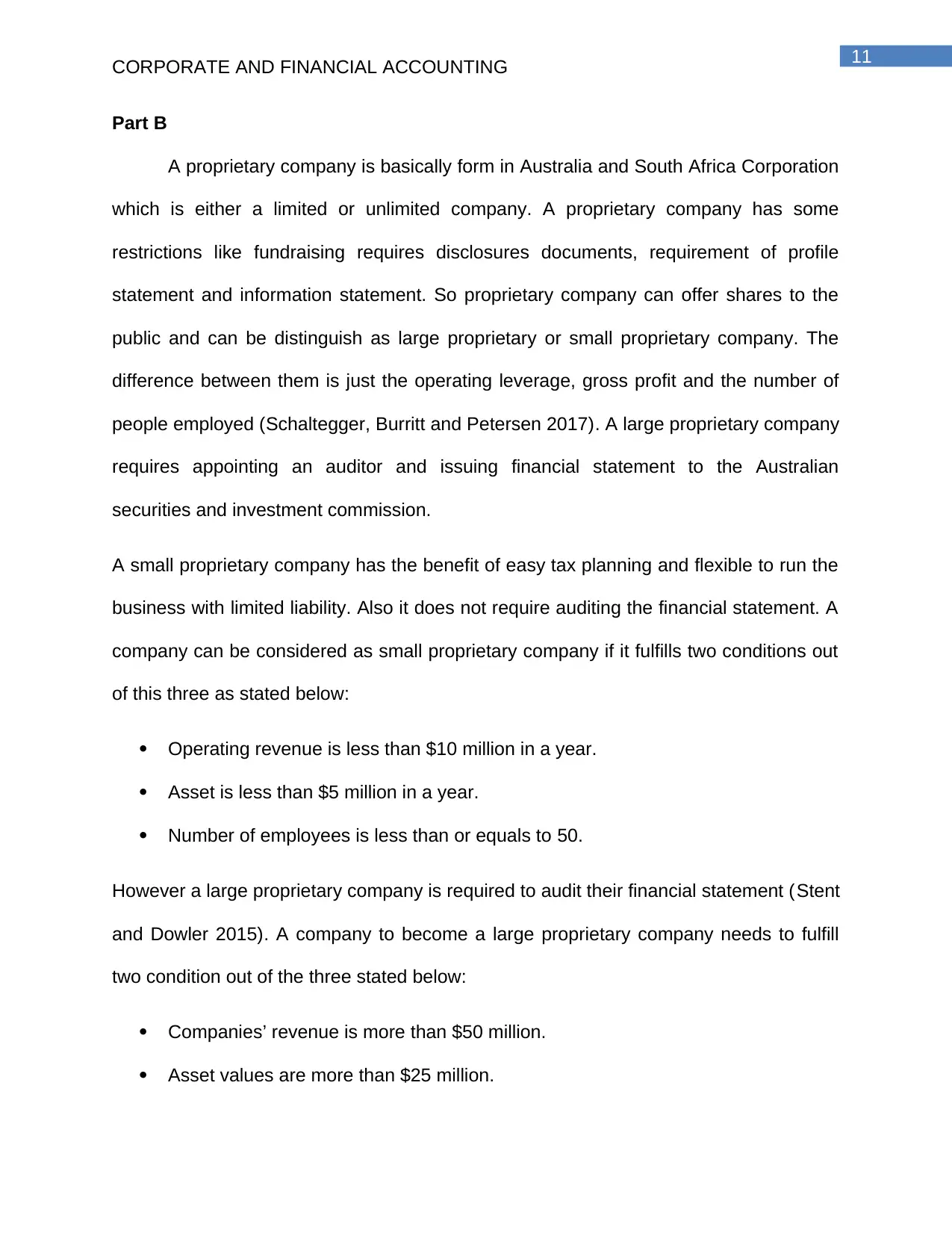
11
CORPORATE AND FINANCIAL ACCOUNTING
Part B
A proprietary company is basically form in Australia and South Africa Corporation
which is either a limited or unlimited company. A proprietary company has some
restrictions like fundraising requires disclosures documents, requirement of profile
statement and information statement. So proprietary company can offer shares to the
public and can be distinguish as large proprietary or small proprietary company. The
difference between them is just the operating leverage, gross profit and the number of
people employed (Schaltegger, Burritt and Petersen 2017). A large proprietary company
requires appointing an auditor and issuing financial statement to the Australian
securities and investment commission.
A small proprietary company has the benefit of easy tax planning and flexible to run the
business with limited liability. Also it does not require auditing the financial statement. A
company can be considered as small proprietary company if it fulfills two conditions out
of this three as stated below:
Operating revenue is less than $10 million in a year.
Asset is less than $5 million in a year.
Number of employees is less than or equals to 50.
However a large proprietary company is required to audit their financial statement (Stent
and Dowler 2015). A company to become a large proprietary company needs to fulfill
two condition out of the three stated below:
Companies’ revenue is more than $50 million.
Asset values are more than $25 million.
CORPORATE AND FINANCIAL ACCOUNTING
Part B
A proprietary company is basically form in Australia and South Africa Corporation
which is either a limited or unlimited company. A proprietary company has some
restrictions like fundraising requires disclosures documents, requirement of profile
statement and information statement. So proprietary company can offer shares to the
public and can be distinguish as large proprietary or small proprietary company. The
difference between them is just the operating leverage, gross profit and the number of
people employed (Schaltegger, Burritt and Petersen 2017). A large proprietary company
requires appointing an auditor and issuing financial statement to the Australian
securities and investment commission.
A small proprietary company has the benefit of easy tax planning and flexible to run the
business with limited liability. Also it does not require auditing the financial statement. A
company can be considered as small proprietary company if it fulfills two conditions out
of this three as stated below:
Operating revenue is less than $10 million in a year.
Asset is less than $5 million in a year.
Number of employees is less than or equals to 50.
However a large proprietary company is required to audit their financial statement (Stent
and Dowler 2015). A company to become a large proprietary company needs to fulfill
two condition out of the three stated below:
Companies’ revenue is more than $50 million.
Asset values are more than $25 million.
⊘ This is a preview!⊘
Do you want full access?
Subscribe today to unlock all pages.

Trusted by 1+ million students worldwide
1 out of 17
Related Documents
Your All-in-One AI-Powered Toolkit for Academic Success.
+13062052269
info@desklib.com
Available 24*7 on WhatsApp / Email
![[object Object]](/_next/static/media/star-bottom.7253800d.svg)
Unlock your academic potential
Copyright © 2020–2025 A2Z Services. All Rights Reserved. Developed and managed by ZUCOL.





